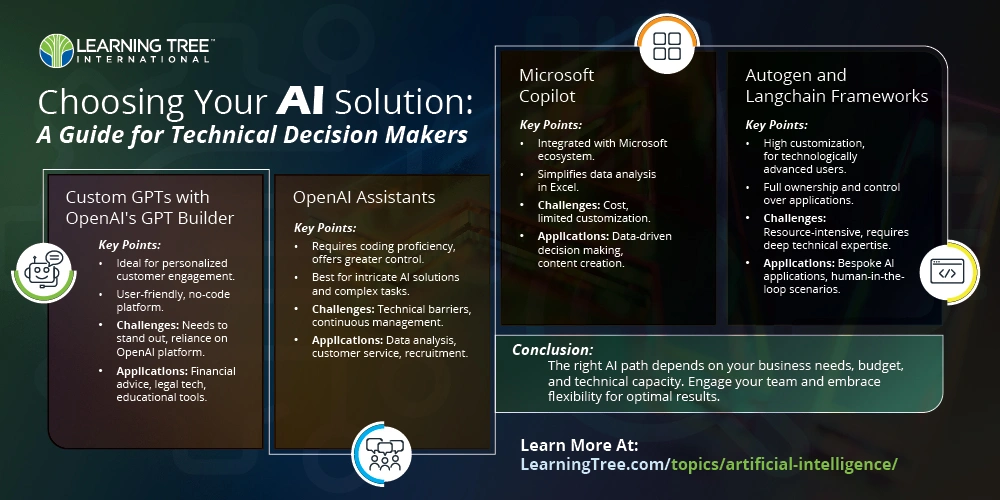In the ever-changing landscape of artificial intelligence (AI), businesses are continuously seeking ways to apply this transformative AI technology. The acceleration of AI adoption has permeated every facet of business operations, presenting challenges and opportunities for leveraging AI. Check out Learning Tree's 1-day AI Introduction for hands-on experience with key concepts in modern AI and discuss how they apply to you and your business.
Here, we examine four strategic pathways for businesses to initiate their AI journey, examining the advantages and considerations of each: Custom GPTs, AI Assistants, Microsoft Copilot, and development frameworks Autogen and Langchain.

Building Custom GPTs with OpenAI's GPT Builder
The GPT Builder from OpenAI is useful for businesses needing more technical expertise. Its user-friendly, no-code platform empowers businesses to create custom chatbots tailored to internal or external use cases. This democratisation of AI facilitates personalised customer engagement and offers a potential marketplace for brand promotion or even monetising sort-after custom models, or "GPTs". However, the journey has its challenges.
Your GPT must stand out amongst the tens of thousands available for free. The requisite subscription to access the GPT Builder introduces a minor financial consideration (you'll need a GPT-PLUS account), and as the platform gains popularity, creating that distinct chatbot becomes increasingly challenging. Moreover, reliance on OpenAI's platform could potentially constrain future scalability and integration prospects. We've struggled with platform availability and stability this last month.
But if OpenAI improves the service, we are hopeful there will be significant benefits for a wide range of use cases. The financial sector, for example, is set to benefit through personalised financial advice, market analysis, and customer service. If designed and tested well, these GPTs can understand the complexities of financial language and regulations.
Custom GPTs can also be trained to understand legal jargon and assist with contract analysis, compliance checks, and legal research. Again, if done well, this use case represents a significant advancement in legal tech, potentially reducing the time and cost associated with legal processes.
Custom GPT models can be fine-tuned for specific languages and dialects, enabling businesses to localise their services and products effectively. This capability is crucial for global companies seeking to maintain a consistent brand voice across diverse markets.
Custom GPT models may well revolutionise the educational sector by providing personalised learning experiences. Tailored GPTs can cater to individual learning styles and paces, making education far more accessible and practical. This could potentially bridge the educational divide by offering high-quality, customised tutoring at a fraction of the cost.
Sales and marketing will continue to be fertile grounds for custom GPTs. One of the most compelling use cases is the ability to deliver personalised experiences at scale. For instance, a custom GPT can be trained to understand the nuances of a brand's voice and provide customer support that aligns with the company's values and tone. The creation of 'X Optimizer GPT' by AI influencer Rowan Cheung exemplifies the power of custom GPTs in content creation.
This GPT automatically analyses and fine-tunes social media posts, ensuring the content reaches its peak potential. For marketers and content creators, such a tool can be invaluable in optimising engagement and reach.
In the UK, accounting and tax consultancies are trialling custom GPTs internally to answer detailed questions about new tax legislation released by the UK Treasury. We've also seen very creative use cases in the private equity space, particularly around acquisition due diligence, where consultants typically need reformatted reports that map a target's questionnaire answers into a standardised and summarised format with annotations based on a 'Knowledge' file or context information.
The key here is the use of Knowledge files to make the GPT focus and relate answers to your corporate data. Custom Actions allow you to plug into other automation services/APIs such as Relevance or Zapier. Rigorous testing is imperative, but you're getting a powerful AI with tools to operate chains of Career Stages and curation, all no-code.
Many more GPTs will be promoted once Open AI unveils its marketplace, which promises to be similar to the Apple App Store or the Google Play Store.
Multiple OpenAI Assistants
OpenAI Assistants represent a more sophisticated avenue for AI adoption, demanding a degree of coding proficiency. This approach affords businesses greater control, enabling the construction of intricate AI solutions and integration with diverse tools and specialised functions. The potential to form collaborative AI teams enhances the complexity and scope of tasks. However, the technical barriers may exclude some businesses, and the time investment required for setup and maintenance is not insignificant.
Managing a consortium of AI assistants, trained for specific roles using distinct AI models, also introduces an element of complexity, necessitating continuous management and oversight.
A compelling application of multiple OpenAI Assistants is in the field of data analytics. Imagine a scenario where an AI assistant dedicated to data retrieval works in tandem with another that specialises in data interpretation and works with another performing competitor analysis. The retrieval assistant can sift through extensive databases to extract relevant data points, while the interpretation assistant can analyse the data, offering insights and recommendations. These results are then compared externally by a competitor assistant. This multi-assistant approach can significantly enhance the efficiency and accuracy of data analysis tasks, which are often cumbersome and time-consuming when performed by humans alone or insufficient if performed by a single GPT.
The customer service industry can significantly benefit from deploying multiple AI assistants. A chatbot assistant can handle initial customer inquiries, quickly responding to common questions. But when an inquiry becomes too complex, the chatbot can seamlessly transfer the conversation to a specialised assistant with advanced capabilities to handle specific issues, such as technical support or billing queries. This tiered approach to AI customer service ensures that customers receive the appropriate level of assistance promptly, improving overall satisfaction and efficiency.
One of our clients, a recruitment consultancy, asked that a team of AI assistants represent their whole workforce, from recruitment agents to Account Directors. The AI assistants would communicate how well a CV matched a job spec. Still, further conversations and ideas were created when the Account Director's assistant promoted additional business opportunities with the client based on the candidate's hidden skills and experience.
These tangential or "adjacent" opportunities were not always obvious to their human counterparts. And if you thought the staff felt threatened by their mirror assistants, then think again. Most staff got ideas from studying the AI assistants' interactions. In fact, the staff wanted to keep enhancing their own assistants' definitions. Perhaps this is the future of work: continual, healthy competition with your AI avatar or assistant?
Microsoft AI: Copilot
For businesses entrenched in the Microsoft ecosystem, Microsoft Copilot offers a harmonious transition into AI, leveraging familiar enterprise software to reduce the learning curve for employees and boost productivity across applications. However, this pathway is less suited for businesses that do not predominantly use Microsoft products. Furthermore, Copilot is costly and has yet to be available to all.
While a powerful tool out of the box, it may not provide the same depth of customisation as other AI solutions and quantifying the return on investment (ROI) in terms of productivity gains and efficiency improvements could be elusive.
One of the standout applications of Microsoft Copilot is within Microsoft Excel. The generative AI assistant can interact with data by creating formulas, revealing correlations, identifying trends, and generating 'what if' scenarios. It simplifies complex data analysis, making it accessible to users without in-depth statistical or database knowledge.
For instance, a user might ask Copilot to identify a dataset's most significant sales drivers. Copilot would perform the analysis and create visualisations to represent the findings.
There are, of course, even bigger advantages when applications collaborate with each other. Copilot ensures data and content continuity across applications. As it operates on the Microsoft Graph, a user's preferences and data are accessible across all integrated apps, allowing Copilot to provide contextually relevant assistance. This means that insights derived from data in Excel can inform content creation in Word or PowerPoint.
Developing Applications with Autogen or Langchain Frameworks
On the more technologically advanced end of the spectrum, frameworks like Autogen or Langchain present an opportunity for businesses to develop bespoke AI applications. These frameworks offer unparalleled customisation, fostering the development of innovative and cutting-edge AI solutions predominantly in the Python programming language.
This approach is resource-intensive, demanding both technical expertise and significant investment in time and finances. Moreover, the integration of these custom solutions into existing business processes can be a complex undertaking. Yet, businesses retain full ownership and control over their applications, tailoring them to specific needs and challenges.
Explore Python Training On-Demand, one of our many fundamental skills courses that give you the most control over your solutions and data.
Again, the multi-agent scenario could be the most powerful for those wanting to push the boundaries of AI, creating a whole workforce with different roles. An innovative feature of these frameworks is the "human proxy agent", which allows human operators to step in and participate in AI agent conversations when necessary.
This ensures the AI system can handle unexpected situations or complex queries requiring human intuition or decision-making skills. It's human-in-the-loop but allows AI to do most of the work.
Which AI solution is right for you?
There are many paths to AI for businesses depending on your patience, workforce, budget, and technical capabilities. Businesses seeking user-friendly and quick-to-deploy solutions may gravitate towards OpenAI's GPT Builder and Microsoft Copilot.
In contrast, those requiring more detailed and complex AI solutions might find greater value in OpenAI's Assistants API and development frameworks like Autogen or Langchain.
Ultimately, the path choice should be aligned with your business's specific needs and strategic aspirations. But you'll learn the most by getting your hands dirty, involving as many of your staff as possible, and being honest and flexible about the results.
Make the best data-driven decisions in less time with tools and insights at our AI Solutions page, and follow Learning Tree International on LinkedIn to stay up to date on the latest resources.


